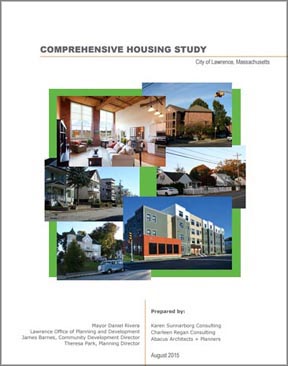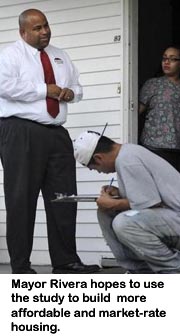Posted on September 1, 2015
 LAWRENCE, Sept. 1, 2015 --- A new study commissioned by the City of Lawrence provides a complete picture of the challenges the city faces as it moves to find strategies to address its growing population, high rents, low housing production and aging housing supply.
LAWRENCE, Sept. 1, 2015 --- A new study commissioned by the City of Lawrence provides a complete picture of the challenges the city faces as it moves to find strategies to address its growing population, high rents, low housing production and aging housing supply.
With no master plan in place, the city council, the housing authority, advocates and nonprofit housing developers like Lawrence Community Works have been saying a study was needed. After Mayor Dan Rivera was elected in 2013, a housing study was one of the top recommendations made by the mayor's transition team.
The $46,000 study was prepared by two consultants - Karen Sunnaborg and Charleen Regan - along with Abacus Architects + Planners. It was funded by the City of Lawrence, TD Bank, the Lawrence Housing Authority, Winn Development, Metro Credit Union and MHP's community assistance team.
The study identified many areas of concern. They include:
• Much of the housing stock is old and in need of repair. The study found that more than half of the housing stock was built before World War II.
• Low property values mean owners are financially constrained as to the amount of improvements they can make. Median sales prices are $188,000 for a single-family, $75,000 for a condo, and $200,500 for a two-family, the study said.
• Rents are rising due to low housing growth and a rising population. From 1980 to 2012, the city had a housing growth rate of 1.9 percent relative to a 22 percent population growth (from 63,000 to 77,000).
• The vacancy rate for rental housing is 3.8 percent. Anything below 5 percent represents tight market conditions. About 72 percent of the housing is rental.
• Of the 27,000 housing units, 3,900 (14 percent) are considered subsidized. The city is in danger of losing some of this as affordable use restrictions on 10 properties representing 736 units are set to expire by 2019.
• After the rate of owner-occupied housing between 1980-2000 grew to 32 percent, the numer of owner-occupied units declined by 9.6 percent through 2010 due to the foreclosure crisis and properties being converted to investor-owned.
• The study did note that while Lawrence was initially hard hit by foreclosures, it recovered faster and saw a more dramatic decline in distress than other gateway cities. The study credited the use of the state's Neighborhood Stabilization Loan Fund (NSLF) to acquire and stabilize foreclosed properties as one factor in the city's recovery. The study also credited MHP's ONE Mortgage Program for first-time homebuyers as being a factor in achieving owner occupany. MHP also helped create, support and fund NSLF.
 • Market-rate rents are about $1,100, which would be affordable to a household earning $50,800. This is out of reach for many in the city where the median income is $30,059. Median rent is $995, still out of reach for many residents. A family of four would need to earn $46,600 to afford a median rent plus the estimated $170 in utilities, the study said.
• Market-rate rents are about $1,100, which would be affordable to a household earning $50,800. This is out of reach for many in the city where the median income is $30,059. Median rent is $995, still out of reach for many residents. A family of four would need to earn $46,600 to afford a median rent plus the estimated $170 in utilities, the study said.
• There is high rent burden and churn. The study estimates that 40 percent spend more than half their income on rent (spending anything above 30 percent is considered burdened). As of 2012, almost 40 percent of residents had lived in their homes for less than two years.
• Using estimates provided by the Metropolitan Area Planning Council, household growth is expected to rise 30 percent from 25,000 to 33,000 by 2030, meaning the city needs to build 410 units per year to keep up. From 2000-2009, the city averaged only 310 units per year.
• The study did note building permit activity has picked up, with $155 million in investment involving 3,200 permits since 2012.
The study was unveiled recently at Northern Essex Community College. Afterwards, Mayor Rivera told the Lawrence Eagle Tribune, "What’s important here is that we need to figure out how to build more housing in dense neighborhoods,” Rivera said “We’re going to try to roll out a plan to add housing at the right mix, not all low-income and not all market rate, but housing that will let people who currently live here afford to live here. We need to grow just as much market rate as low- to moderate-income housing.”
